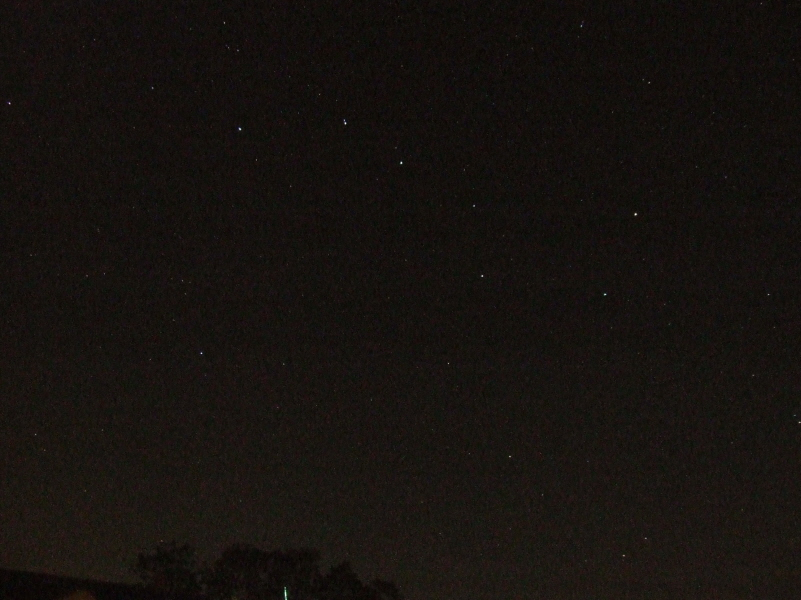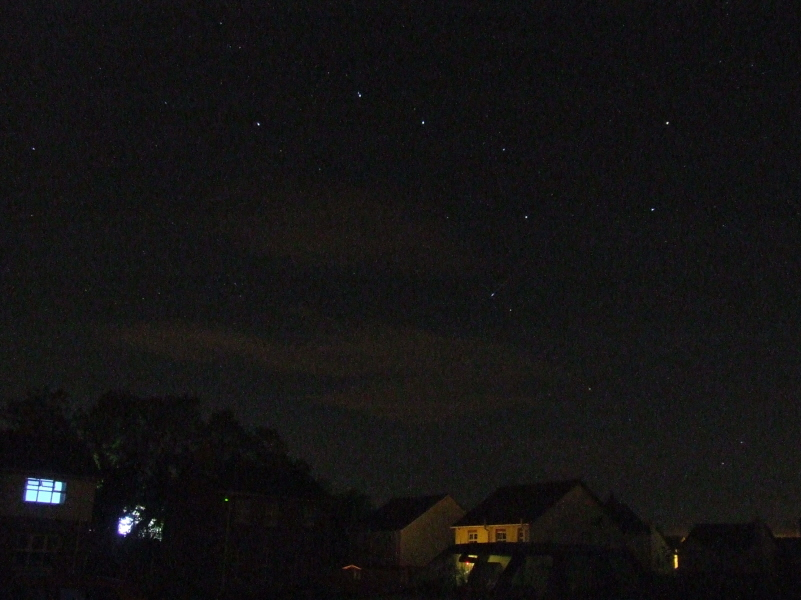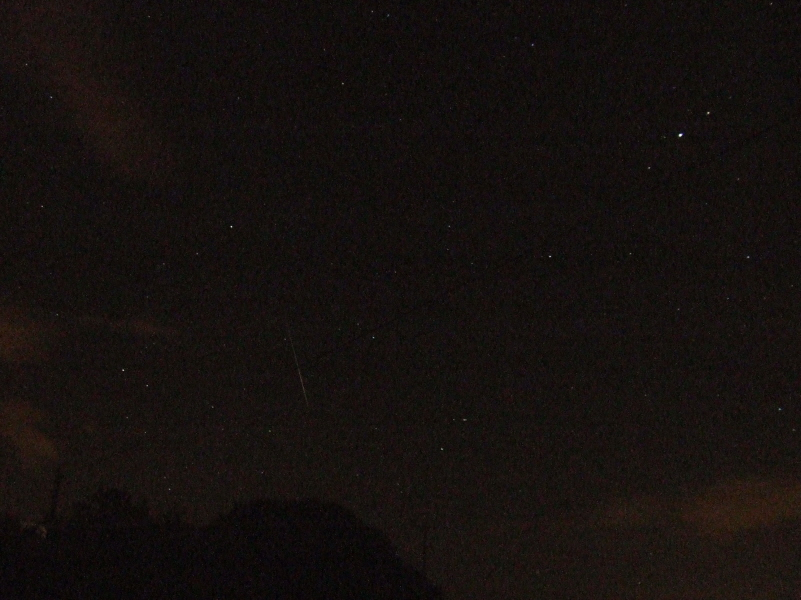 |
00.27 - 03.45 BST
I had a stunning dark, beautiful clear night here. It was very cold with slight air frost. The Milky Way was astounding with bright streamers splitting in two and curving through Aquila and Ophiuchus with distinct dark dust lanes in Cygnus. The 'North American Nebula' and 'Coat hanger' asterism were easy naked eye treats. I was searching for comets through the western evening sky with the 8.5" reflector and after 40 minutes I simply had to stop as the meteor activity was so good! With five days to go until Perseid maximum I knew the Earth would be entering a denser stream of material so I set up the camera and began a serious meteor patrol. I choose a productive area of sky within Ursa major, Canes Venatici and Coma Berenices. I ended up staying out all night taking images until my battery went dead.
I observed 38 meteors in total of which 25 were Perseids and 13 were non Perseids (there are other minor showers active during this period). At times I seen 2 at the same time and even 'chasers' when one followed behind another. I observed 2 fireballs. The best was at 00.31 BST when a large emerald green magnitude - 6 tailless beauty dropped into the west very low on the horizon into Coma Berenices. It cast shadows and I could actually see it moving behind the dark form of trees along the Coleraine road as it shimmered through gaps in the branches. It was a magnificent sight as I could see its light reflecting off tree branches/leaves and rooftops. Luckily that was where I was patrolling however it was so low that I just picked up its green trail at the bottom of an image behind trees. I was talking with John Mc Connell over the phone while we both monitored the sky. Another magnitude + 2.0 Perseid shot through Ursa Major sporting an orange head and long blue tail which I also caught on my patrol image. I said to John over the phone 'I caught that one!'. A fantastic night of Perseid action. I can only imagine what the activity will be like on the night of maximum!
 |
 |
Last nights Perseid meteor maximum was the first I have watched on my own for several years which made it even more enjoyable as it reminded me of my earlier days when I first began meteor watching over 10 years ago so it felt good to have my own private communion with the sky. I had plans to meet several observers for this all night session however because it landed on a Sunday night with a very poor weather forecast most people gave it a miss as things did not look promising.
My batteries were charged and I began the night by watching the 22.02 ISS pass during bright evening twilight. The space shuttle endeavor was currently docked with the station and in the days before I had watched its launch live on NASA TV which was very exciting. As darkness fell the clouds increased making for a very challenging time as I had to fight for every meteor seen. It was a calm, mild, wet night with very slow eastward drifting broken Cumulus. The sky was dark and the trans varied greatly. Here is a quick summary of my unbroken hourly observations.
23.00 - 00.00 BST
Perseids = 3, Non Shower Meteors = 2, Total = 5
95% cloudy. trans = 5, limiting magnitude +4.5, clear strip low in W - NW sky. Light drizzle at one stage.
00.00 - 01.00 BST
Perseids = 10, Non Shower Meteors = 1, Total = 11
90 - 95% cloudy, limiting magnitude + 5, stayed overcast for most of this hour. Seen one very nice borderline fireball and two fainter Perseids in chase one behind the other.
01.00 - 02.00 BST
Perseids = 8, Non Shower Meteors = 3, Total = 11
60 - 70% cloudy, trans = 8, limiting magnitude +6.2. Milky Way very bright with dark dust lanes, variable star RCrB still in outburst and invisible with naked eye. Clear along NE and NW - S sky sectors.
02.00 - 03.00 BST
Perseids = 34, Non Shower Meteors = 2, Total = 36
From country location, 60% cloudy, trans = 8, limiting magnitude + 6.2. Seen a wonderful orange fireball moving N to S at its brightest just south of the Zenith which produced a double flash and illuminated cloud. I listened for sound but none was heard. Several Perseids at 0 magnitude also seen and several 'chasers'.
03.00 - 04.00 BST
Perseids = 24, Non Shower Meteors = 2, Total = 26
Sky 80% cloudy, Clear in SW - N and patchy at zenith. Seen fabulous fireball high in NW which left a long straight blue ion train for 30 seconds! This was the highlight of the night. Big increase in fireball activity around this time and many seen lighting up the cloud from behind like orange daggers. The greatest abundance of these appeared in Ursa Minor and Draco.
04.00 - 04.18 BST
Perseids = 4, Non Shower Meteors = 1, Total = 5
Sky 95% clear, small clear gaps in Taurus, Perseus, Auriga, Pegasus and Cetus. Many fainter Perseids slicing through the square of Pegasus during the last 30 minutes. M45 (Pleiades) nicely placed above Mars. Seen another brilliant fireball as a very large colourless disk with no tail shoot from N to S behind clouds. I could see its Moon-like disk moving behind a large blanket of orange cloud at an incredible speed which seemed swifter than all the previous Perseids I have witnessed tonight. Session ended at 04.18 due to clouds.
Total Perseids Observed = 83
Total Non Shower Meteors Observed = 11
Total Meteors observed = 94
I think a count of 94 meteors is quite exceptional for a single observer under a mostly cloudy sky! Last year I seen 137 throughout the entire clear night. This years Perseids seemed very active indeed and what was exciting was the large amount of fireballs which was incredible to watch particularly in the pre dawn hours when they tended to burn up east of the zenith in Ursa Major and Draco. Many bright members also favoured Aquila, Bootes, Corona Borealis and Pegasus. The best location again proved to be Ursa Major. Luckily my batteries held out for the entire night (helped somewhat by the mild temperature) and I managed to fill my memory card several times with patrol images. Many Perseids passed though my images however they were too faint for my camera to detect, I did catch a few but the best was a magnitude + 2.0 orange Perseid with long tail which cut down through the centre of capricornus!
 |
A very successful night despite the clouds. I will be trying again on the following night.
I did a watch last night from 01.35 - 03.30 BST. Sky as not good with 85% cloud cover, very mild, calm and quite. A few decent clear patches appeared in the N and W. Seen 16 meteors of which 14 were Perseids and 2 non shower members. The highlight was a spectacular fireball at 03.08 BST heading from the Perseid radiant in the high NE into the W at a 45 degree angle. It soared through the sky at incredible speed sporting a large disk-like head (1 degree in diameter) with a long straight narrow tail. Bright white and blue colours clearly seen. It moved behind a blanket of cloud and flashed brightly illuminating the cloud from the behind. It burnt up within Hercules and at its peak it was must have been magnitude - 8.0 or perhaps even brighter! I never heard a sonic boom from the event although I suspect it left in its wake a wonderful twisted smoke train behind the cloud. This was the best Perseid fireball I have seen over the last few nights!
I did a watch last night from 01.35 - 03.19 BST and there was still very good activity. I counted 35 meteors of which 33 were Perseids and 2 non shower members. Milky Way was astounding in a dark crystal clear sky stretching from horizon to horizon with three sections of milky streamers and complex high contrast dark dust features which were so outstanding that it reminded me of a high exposure DSLR image from the likes of Keith Geary (well known astrophotographer from South of Ireland). Non of the meteors were bright but I was surprised by the rich activity. Gemini and Orion could be seen climbing from horizon haze.
Number of Nights Observing = 4
Total Time Observing = 13 hours 15 minutes
Number of Meteors Observed Over 4 Nights = 183
Number of Perseids Observed Over 4 Nights = 155
Number of Non-Shower Meteors Observed Over 4 Nights = 28
Martin Mc Kenna